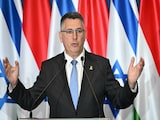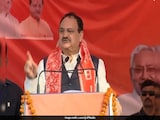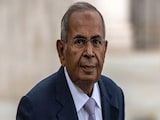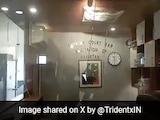Mumbai:
"No, no, no. You have all misunderstood me," an angry Congress leader Raj Babbar thundered over the phone on Thursday. "I was referring to the poorest of poor and not the middle class."
"But sir, even for the below poverty level, where will they find a fulsome Rs 12 meal in Mumbai?" I asked urging him to join us to any such location he had in mind.
"I can't join you as my son Prateik's film is releasing tomorrow but I will text you the address," Mr Babbar reassured.
As expected, the text message never came. Nonetheless, the next morning we embarked to find - what was now infamously nicknamed 'Babbar da Dhaba': an eatery that served "Rs 12 meal of rice, daal, sambhar and vegetables."
And so, as "clarified" by Mr Babbar, we looked for a place where those below the poverty line would go eat a "fulsome Rs 12 meal."
Pila Bungalow, Dharavi, Mumbai. Asia's largest slum. This is where some of India's poorest of the poor live. Without exception, the air here always smells of sewage. After all, Dharavi was right next to the Mithi river, which had long turned into a gutter. The monsoon had only worsened the situation as the sewers freely overflowed on to the roads.
"Where will we find the cheapest food around here?" I asked a paan wala.
"Take a right, 50 m ahead. Dal and rice are available there," he murmured.
"How much does a full plate of daal and rice cost?" I enquired.
"Full plate is Rs 40. Half plate, Rs 20," a man responded introducing himself as Riyaz Ahmed on seeing our camera as a crowd gradually gathered around us.
"Would I find a cheaper restaurant anywhere here?"
In unison the crowd erupted, "No, no. This is the cheapest place to eat."
"Any meal for Rs 12?" I asked. And again, in unanimity the crowd giggled at the bizarre question.
I immediately informed them that Mr Babbar had, not once but twice, proclaimed it was indeed available.
"Sir, how is it possible? Today a vada pav costs Rs 10. A cutting chai is Rs 6. Even to go to a pay-and-use toilet one is charged Rs 3," Riyaz said as he emptied a plate of dal and rice in a small white plastic bag. "Raj Babbar can say what he wants. Hakeekat kaafi alag hai."
So what sort of meal was available for Rs 12? On my persuasion, Riyaz packed a plate of dal and rice worth just that much: Rs 12.
Our next stop: Babulnath, South Mumbai.
"That's just 250 grams," wellness guru Mickey Mehta said weighing the packet on an electronic scale. "That's hardly a meal!"
We had taken along two vada pavs too. But since they cost us Rs 20, we weighed one and added only one-fifth of the other. "That's vada pav worth Rs 12. 150 grams," Mehta said.
"This much rice will simply vanish away in anyone's stomach and especially those who are poor as they normally do physical labour. A normal person needs about 1700 calories a day. The poor need between 2,000 and 2,500 as they exert themselves much more," Mehta explained. "Raj Babbar's statement is ridiculous."
We know that too, Mr Mehta. But sometimes, one has to literally bring an obvious ground reality before the eyes of our netas.
It won't change the state of the poor but their mockery at least needs to be blunted.
"But sir, even for the below poverty level, where will they find a fulsome Rs 12 meal in Mumbai?" I asked urging him to join us to any such location he had in mind.
"I can't join you as my son Prateik's film is releasing tomorrow but I will text you the address," Mr Babbar reassured.
As expected, the text message never came. Nonetheless, the next morning we embarked to find - what was now infamously nicknamed 'Babbar da Dhaba': an eatery that served "Rs 12 meal of rice, daal, sambhar and vegetables."
And so, as "clarified" by Mr Babbar, we looked for a place where those below the poverty line would go eat a "fulsome Rs 12 meal."
Pila Bungalow, Dharavi, Mumbai. Asia's largest slum. This is where some of India's poorest of the poor live. Without exception, the air here always smells of sewage. After all, Dharavi was right next to the Mithi river, which had long turned into a gutter. The monsoon had only worsened the situation as the sewers freely overflowed on to the roads.
"Where will we find the cheapest food around here?" I asked a paan wala.
"Take a right, 50 m ahead. Dal and rice are available there," he murmured.
"How much does a full plate of daal and rice cost?" I enquired.
"Full plate is Rs 40. Half plate, Rs 20," a man responded introducing himself as Riyaz Ahmed on seeing our camera as a crowd gradually gathered around us.
"Would I find a cheaper restaurant anywhere here?"
In unison the crowd erupted, "No, no. This is the cheapest place to eat."
"Any meal for Rs 12?" I asked. And again, in unanimity the crowd giggled at the bizarre question.
I immediately informed them that Mr Babbar had, not once but twice, proclaimed it was indeed available.
"Sir, how is it possible? Today a vada pav costs Rs 10. A cutting chai is Rs 6. Even to go to a pay-and-use toilet one is charged Rs 3," Riyaz said as he emptied a plate of dal and rice in a small white plastic bag. "Raj Babbar can say what he wants. Hakeekat kaafi alag hai."
So what sort of meal was available for Rs 12? On my persuasion, Riyaz packed a plate of dal and rice worth just that much: Rs 12.
Our next stop: Babulnath, South Mumbai.
"That's just 250 grams," wellness guru Mickey Mehta said weighing the packet on an electronic scale. "That's hardly a meal!"
We had taken along two vada pavs too. But since they cost us Rs 20, we weighed one and added only one-fifth of the other. "That's vada pav worth Rs 12. 150 grams," Mehta said.
"This much rice will simply vanish away in anyone's stomach and especially those who are poor as they normally do physical labour. A normal person needs about 1700 calories a day. The poor need between 2,000 and 2,500 as they exert themselves much more," Mehta explained. "Raj Babbar's statement is ridiculous."
We know that too, Mr Mehta. But sometimes, one has to literally bring an obvious ground reality before the eyes of our netas.
It won't change the state of the poor but their mockery at least needs to be blunted.















